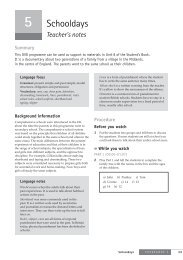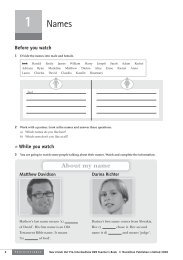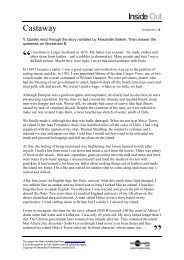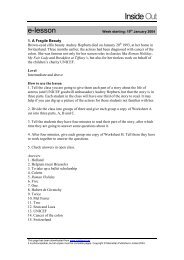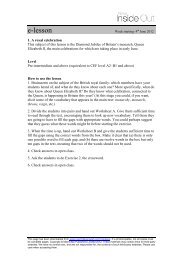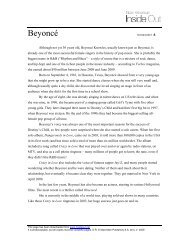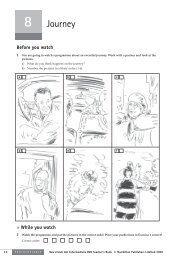No ordinary chunk of ice WORKSHEET A - Inside Out
No ordinary chunk of ice WORKSHEET A - Inside Out
No ordinary chunk of ice WORKSHEET A - Inside Out
You also want an ePaper? Increase the reach of your titles
YUMPU automatically turns print PDFs into web optimized ePapers that Google loves.
Halloween<br />
<strong>WORKSHEET</strong> A<br />
Exercise 1<br />
Complete the questions at the bottom <strong>of</strong> the page. Then ask your partner the questions<br />
and complete the text.<br />
The name Halloween comes from (All) (1) ‘____________ E’en’, which means<br />
‘Holy Evening’; in other words, the night before All Saints’ Day. Although this is the<br />
original Christian name for the evening <strong>of</strong> 31 st October, the tradition goes back much<br />
further.<br />
Two thousand years ago, in what is now Great Britain and northern France, the<br />
(3) ____________ celebrated the last day <strong>of</strong> the year on 31 st October. This was the<br />
end <strong>of</strong> their harvest season and the beginning <strong>of</strong> winter, and they believed that their<br />
god <strong>of</strong> death, who was called Samhain, freed the spirits <strong>of</strong> the dead on this day so that<br />
they could (5) ____________________________________. People left <strong>of</strong>ferings for<br />
their ancestors and other good spirits, and prayed for their safe return. At the same<br />
time, to scare away the evil spirits, they lit huge fires and wore frightening<br />
(7) ____________.<br />
The fires attracted insects which in turn attracted bats, and because <strong>of</strong> the connections<br />
with the dead, magic and scary dress, we have come to associate all sorts <strong>of</strong> monsters,<br />
witches and animals with the holiday.<br />
(9) ____________ used to go door to door with lanterns carved from seasonal<br />
vegetables such as pumpkins and beg for food in return for prayers for the safe return<br />
<strong>of</strong> the dead family members. This is where the tradition <strong>of</strong> ‘Trick-or-Treat’ comes<br />
from: children in costumes knock on doors and are given (11) ____________ (a treat)<br />
or else they may play a trick like the evil spirits.<br />
1. Where ________________________________________________________?<br />
3. Who _________________________________________________________?<br />
5. Why _________________________________________________________?<br />
7. What _________________________________________________________?<br />
9. Who _________________________________________________________?<br />
11. What _________________________________________________________?<br />
This page has been downloaded from www.macmillanenglish.com/insideout. It is photocopiable, but all copies must<br />
be complete pages. Copyright © Macmillan Publishers Limited 2012. These materials may contain links for third-party<br />
websites. We have no control over, and are not responsible for, the contents <strong>of</strong> such third-party websites. Please use<br />
care when accessing them.
Halloween<br />
<strong>WORKSHEET</strong> B<br />
Exercise 1<br />
Complete the questions at the bottom <strong>of</strong> the page. Then ask your partner the questions<br />
and complete the text.<br />
The name Halloween comes from (All) ‘Hallows E’en’, which means<br />
(2) ‘________________________’; in other words, the night before All Saints’ Day.<br />
Although this is the original Christian name for the evening <strong>of</strong> 31 st October, the<br />
tradition goes back much further.<br />
Two thousand years ago, in what is now Great Britain and northern France, the Celts<br />
celebrated the last day <strong>of</strong> the year on 31 st October. This was the end <strong>of</strong> their harvest<br />
season and the beginning <strong>of</strong> winter, and they believed that their god <strong>of</strong> death, who<br />
was called (4) ____________, freed the spirits <strong>of</strong> the dead on this day so that they<br />
could visit their families. People left (6) ____________ for their ancestors and other<br />
good spirits, and prayed for their safe return. At the same time, to scare away the evil<br />
spirits, they lit huge fires and wore frightening costumes.<br />
The fires attracted insects which in turn attracted (8) ____________, and because <strong>of</strong><br />
the connections with the dead, magic and scary dress, we have come to associate all<br />
sorts <strong>of</strong> monsters, witches and animals with the holiday.<br />
People used to go door to door with lanterns carved from seasonal vegetables such as<br />
pumpkins and beg for food in return for prayers for the safe return <strong>of</strong> the dead family<br />
members. This is where the tradition <strong>of</strong> ‘Trick-or-Treat’ comes from:<br />
(10) ____________ in costumes knock on doors and are given sweets (a treat) or else<br />
they may (12) ____________________________________ like the evil spirits.<br />
2. What _________________________________________________________?<br />
4. What _________________________________________________________?<br />
6. What _________________________________________________________?<br />
8. What _________________________________________________________?<br />
10. Who _________________________________________________________?<br />
12. What _________________________________________________________?<br />
This page has been downloaded from www.macmillanenglish.com/insideout. It is photocopiable, but all copies must<br />
be complete pages. Copyright © Macmillan Publishers Limited 2012. These materials may contain links for third-party<br />
websites. We have no control over, and are not responsible for, the contents <strong>of</strong> such third-party websites. Please use<br />
care when accessing them.
Halloween<br />
<strong>WORKSHEET</strong> C<br />
Exercise 2<br />
Find and circle the ten Halloween words.<br />
B G W I T C H V<br />
J N K C R Y W B<br />
V A M P I R E A<br />
D L I F C Z X T<br />
P U M P K I N F<br />
E H A U O T Q R<br />
V W Z X R B P N<br />
G H O S T Y O M<br />
S P M N R T G O<br />
T Q B K E Z J A<br />
U R I L A D F K<br />
J I E H T E I L<br />
E K D F G C H B<br />
S A C B R O O M<br />
1. witch<br />
2. trick-or-treat<br />
3. boo<br />
4. pumpkin<br />
5. bat<br />
6. ghost<br />
7. skeleton<br />
8. broom<br />
9. vampire<br />
10. zombie<br />
This page has been downloaded from www.macmillanenglish.com/insideout. It is photocopiable, but all copies must<br />
be complete pages. Copyright © Macmillan Publishers Limited 2012. These materials may contain links for third-party<br />
websites. We have no control over, and are not responsible for, the contents <strong>of</strong> such third-party websites. Please use<br />
care when accessing them.



